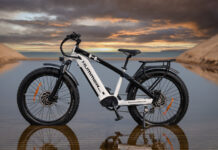The Swiss robot does not need the precision of Swiss watches to move through the forest. A flying ball is not afraid of trees and can bounce off them.
Sometimes being awkward is profitable. Modern flying robots have one major drawback in limited flight conditions – they break when faced with obstacles.
Instead of avoiding obstacles, the new flying robot, designed by Adrien Briod from the Federal Polytechnic School of Lausanne (Switzerland), uses collisions with trees to autonomously fly through the forest for a few hundred meters.
According to the developers, they observed the flight of insects and got inspired to build the robot.
GimBall is a spherical robot equipped with a compass and height sensor, which allows it to move according to the predetermined route. Two propellers driven by electric motors are used to lift the robot, and regulators adjust the direction of flight.
The robot maintains its course due to a new gyro system, consisting of two carbon fiber rings forming a gimbal.
When the robot hits the obstacle, the protective frame in the shape of a soccer ball that rotates freely on the inside absorbs the impact energy.
The invention of Swiss engineers does not have built-in GPS sensors, so its movements seem chaotic. According to the developers, the robot can withstand a collision with a tree at the speed of up to five kilometers per hour, but it will break after a stronger impact.
Sharp objects such as twigs, which can penetrate into the frame gaps, also pose a danger to the robot.
According to the developers, they are going to solve this problem, providing an aircraft with an obstacle recognition system. Briod says that such a system would help it find a way in a building or inside complex objects.
Another advantage of the robot is its unusual weight – 370 grams. According to the inventors, GimBall feels great in smoky rooms where other flying robots cannot be guided by their position sensors. The robot has an onboard video camera, it can lift the load up to 30 grams – it can be a sensor of hazardous gases or radioactive contamination, which can be used in emergency zones.
The robot is controlled remotely, but the creators plan to provide it with a system of artificial intelligence that allows the unit to perform complex tasks and move in difficult conditions.
According to the engineer, the creators’ goal was to give an opportunity to function where other robots fail to work, for example, in buildings destroyed by an earthquake.
GimBall is the latest in a whole line of flying robots with a protective frame, developed in the laboratory of Professor Dario Floreano. Its first trial took place in the woods near Lausanne and showed that the robot bounced off the trees without damage, keeping the general direction of movement. In early November, the ball will be brought to the conference on robotics in Tokyo.







